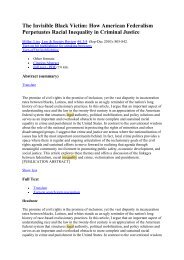Ski – resort and regional development: profile of visitors ... - E-Journal
Ski – resort and regional development: profile of visitors ... - E-Journal
Ski – resort and regional development: profile of visitors ... - E-Journal
Create successful ePaper yourself
Turn your PDF publications into a flip-book with our unique Google optimized e-Paper software.
The carrying capacity <strong>of</strong> mountainous tourist areas: the case <strong>of</strong> plastira’s lake<br />
The carrying capacity <strong>of</strong> mountainous tourist<br />
areas: the case <strong>of</strong> plastira’s lake<br />
Garyfallos Arabatzis, Serafeim Polyzos <strong>and</strong> Stavros Tsiantikoudis<br />
ABSTRACT<br />
garamp@fmenr.duth.gr<br />
spolyzos@prd.uth.gr<br />
stsianti@fmenr.duth.gr<br />
The basic characteristics <strong>of</strong> tourism in Greece are seasonality, massiveness <strong>and</strong> its spatial<br />
orientation having the biggest percentage <strong>of</strong> tourist flows concentrated in coastal areas. In the<br />
last years an important <strong>development</strong> <strong>of</strong> other alternative forms <strong>of</strong> tourism exists, with more<br />
importance in the mountainous tourism. One <strong>of</strong> the most interesting areas for mountainous<br />
tourism with particular environmental characteristics is Plastira’s Lake. This area constitutes<br />
an important tourist pole with impressive increase in nights spent by tourists over the last 10<br />
years. Characteristically, as it is reported, during the years 1995 <strong>–</strong> 1997 arrivals <strong>and</strong> nights<br />
spent by tourists have increased at 440% <strong>and</strong> 425% respectively. During the period 1997 <strong>–</strong><br />
1999 arrivals <strong>and</strong> nights spent by tourists continuously increased at approximately 52% <strong>and</strong><br />
43% respectively.<br />
The augmentative changes in the number <strong>of</strong> tourist arrivals at the area <strong>and</strong> the determination<br />
<strong>of</strong> limits <strong>of</strong> tourism <strong>development</strong> require the estimation <strong>of</strong> tourism carrying capacity. In this<br />
article a methodology <strong>of</strong> estimation <strong>of</strong> tourism capacity <strong>of</strong> the above-mentioned area is<br />
developed, using as basic variables the characteristics <strong>of</strong> the area. Moreover, the intensity <strong>of</strong><br />
the <strong>development</strong> <strong>of</strong> the area is determined, so as to utilize the structured <strong>and</strong> natural environment,<br />
without the environmental degradation.<br />
Key words: tourism <strong>development</strong>, tourism carrying capacity, <strong>regional</strong> <strong>development</strong><br />
INTRODUCTION<br />
Tourism is a global socioeconomic phenomenon based on the human need for recreation,<br />
being in contact with nature <strong>and</strong> getting acquainted with other places <strong>and</strong> cultures. It is an<br />
activity <strong>of</strong> important economical, social, cultural <strong>and</strong> environmental consequence (Fleming<br />
& Toepper, 1990; Coccosis et al. 2001; Page et al. 2001). In a number <strong>of</strong> studies <strong>and</strong><br />
<strong>development</strong>al programs, particularly the economic or social dimension <strong>of</strong> its sequences is<br />
stressed, while the environmental dimensions is underestimated or ignored. The maintenance<br />
<strong>of</strong> balance between tourism <strong>and</strong> the environment imposes the configuration <strong>of</strong> suitable policy<br />
Tourism Today - Fall 2007 - Full Paper<br />
109














